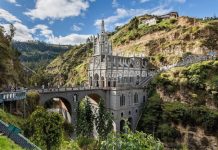For the first time since the outbreak of the war between Israel and Hamas on Oct. 7, the Catholic Church of the Holy Land gathered around its patriarch on the feast day of Our Lady, Queen of Palestine and the Holy Land and reconsecrated the local Church and the entire land to her.
Newsroom (31/10/2023 08:47, Gaudium Press) On Sunday, Oct. 29, Cardinal Pierbattista Pizzaballa, the Latin patriarch of Jerusalem, presided over a Mass at the shrine dedicated to the Blessed Mother in Deir Rafat in the presence of a few hundred faithful.
The attendance was relatively small compared with the thousands of faithful who usually join the celebration from all the communities scattered throughout Israel and the Palestinian territories. However, the circumstances right now prevented a large gathering.
The shrine of Deir Rafat is located halfway between Tel Aviv and Jerusalem in one of the most characteristic regions of ancient Palestine on the border of biblical Philistine, the scene of Samson’s famous exploits. A few kilometers away is Beit Shemesh, where the Ark of the Covenant was returned by the Philistines to the Jewish people (1 Sm 6:1-15). The shrine was built beginning in 1925 and was inaugurated on March 21, 1928, by the then-patriarch of Jerusalem, Monsignor Luigi Barlassina (1920–1947). Above the shrine stands a large bronze statue of Our Lady with her right hand extended over Palestine, her homeland, as a sign of protection.
It was Barlassina who, on the day of the solemn entry into the Basilica of the Holy Sepulcher on July 15, 1920, consecrated the Diocese of the Latin Patriarchate of Jerusalem to Mary at a time marked by strong tensions. The Second World War had just ended, and Palestine was being contested by the Ottoman Empire and the Triple Entente powers (the United Kingdom, France, and Russia).
Eventually, it came under the governance of the United Kingdom (the period between 1920 and 1948 and is known as the “British Mandate”). On that occasion, for the first time, Barlassina invoked Our Lady as “Queen of Palestine.” The Sacred Congregation of Rites approved the title in 1933. The name refers to the entire Holy Land, which was called “Palestine” under the British Mandate.
The feast in honor of Our Lady, Queen of Palestine and patroness of the Latin Patriarchate of Jerusalem, was first celebrated on Aug. 15, 1928. Since 1971, following the liturgical reform of the Second Vatican Council, the feast was moved to Oct. 25, and since then, it has been celebrated on the last Sunday of the month.
“Today, we consecrate once again our Church, our diocese, our land to Our Lady, Queen of Palestine,” Pizzaballa said in his homily. “We have done this several times in moments of need for our community, and this is one of the most difficult in our recent history. It is an act of entrustment and therefore of trust. In this moment when everything seems to be overwhelming us, we need to entrust and deliver to God and the Virgin Mary all that we hold in our hearts.”
At the end of the Mass, the Act of Consecration of the Holy Land to the Immaculate Heart of Mary was read.
The patriarch emphasized the significance of the day’s readings, especially the passage from the Magnificat, which, he said, “overturns our perspective: The powerful are humbled, and the humble are lifted up. We think the world belongs to the powerful, but in the Magnificat, we hear the voice of the humble. The Gospel tells us that the meek shall inherit the earth, not those who destroy. What awaits us is a challenge. I’m not referring to physical destruction but rebuilding trust. That’s why we need meek people; through them, we can rebuild and offer the next generations a land full of beauty.”
Just after the Mass, the traditional procession around the shrine with the statue of Our Lady took place.
Among the celebrants was also the Latin parish priest of Gaza, Father Gabriel Romanelli. When the war broke out, he was in Bethlehem; now he is in Jerusalem. However, he still cannot reunite with his people.
“Why did the Lord want and allow me to be away since the beginning of this war?” he said “Perhaps because from the outside, I can respond differently to many people… but for me, it is a great pain. The greatest pain is not being close to those who are suffering.”
Communication comes and goes, but Romanelli manages to stay in almost daily contact with his vicar, Father Yusuf, and other parishioners. Tears fill his eyes as he describes the situation.
Currently, about 700 people — almost all of Gaza’s Christians — have found refuge in the premises of the Latin parish and the adjacent school, “but everything around is destroyed,” he said.
More than 8,000 people are reported to have died in the Gaza Strip since the beginning of the conflict, and about 20,000 have been injured. After the recent bombings, “many people are under the rubble,” Romanelli said. “For hundreds, it’s not even possible to recognize the bodies.”
Every day, Christians celebrate Mass and pray together, and to share food and essential supplies, although these are starting to run out.
“The danger is real, but they trust that Our Lady and Jesus will protect them from all harm,” Romanelli said. “They pray for peace, peace for everyone, and for the bombings to stop. It can be done, it can be done!”
- Raju Hasmukh with files from CNA































